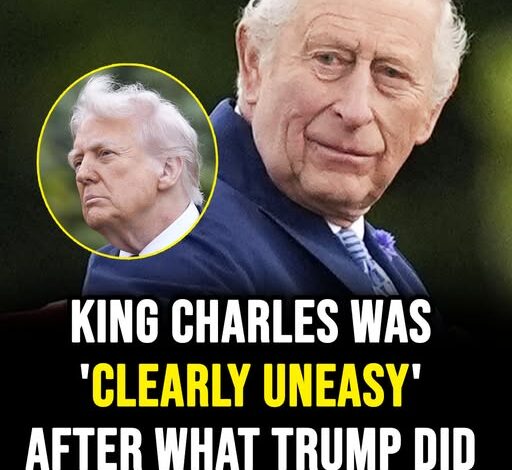King Charles was clearly uneasy after what Trump did during state visit!

Trump Walks Ahead, King Charles Guides: A Glimpse Behind Windsor’s State Visit
Donald Trump’s state visit to the United Kingdom was meant to showcase diplomacy at its most ceremonial: motorcades through Windsor, precise greetings, and military pageantry. Every handshake, step, and camera angle was orchestrated to signal harmony between two nations. Yet amid the glittering choreography, one unscripted moment drew global attention—and left King Charles visibly uneasy.
The incident occurred during the review of the troops, a ritual steeped in centuries of royal protocol. The monarch sets the pace; guests follow. But when it was time to begin, Trump stepped forward before the king, leaving Charles a half-step behind. Cameras captured the subtle tension: the king’s polite half-smile, a brief hesitation, and a minor adjustment of his tie, all signals of split-second recalibration. The scene echoed a similar protocol breach in 2019, when Trump briefly walked ahead of Queen Elizabeth.
Body-language experts noted the delicate dance. Charles had to choose between publicly correcting the guest and risking awkwardness or quietly regaining control. He opted for subtlety, placing a guiding hand on Trump’s back to steer him back into alignment. The gesture, almost imperceptible, transformed a potential breach into a seamless diplomatic reset. By the time they returned toward their seats, the balance of the ceremony had been restored.
Such moments underscore the interplay between personality and protocol. Troop inspections may seem minor, but each step communicates hierarchy, deference, and respect. Royal hosts are trained from childhood to manage these performances flawlessly, while foreign leaders bring instincts shaped by their own traditions. A single misstep, stripped of context, becomes a Rorschach test for the public: arrogance to some, confidence to others, and to keen observers, a masterclass in subtle diplomacy.
The striking contrast—meticulous planning punctured by an unscripted beat—reveals the human side of ceremonial diplomacy. Amid gilded halls and military displays, it is often small gestures—a guiding hand, a hesitant smile, a smoothing of a tie—that tell the truest story. For Charles, it demonstrated the quiet authority of a host; for Trump, it was a moment that passed without apparent notice. Together, they moved on, the official program continuing as if nothing had happened, but the episode offered a rare glimpse into the delicate art of managing protocol under pressure.
Even in events scripted for the history books, improvisation is inevitable. And sometimes, it is these fleeting, unplanned gestures that reveal the subtleties behind the grandeur.